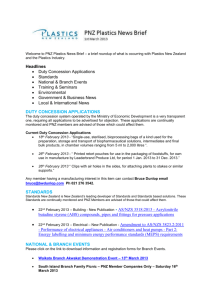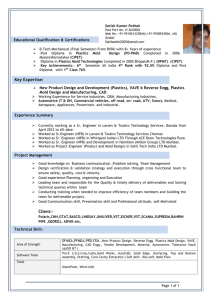EY4056
advertisement
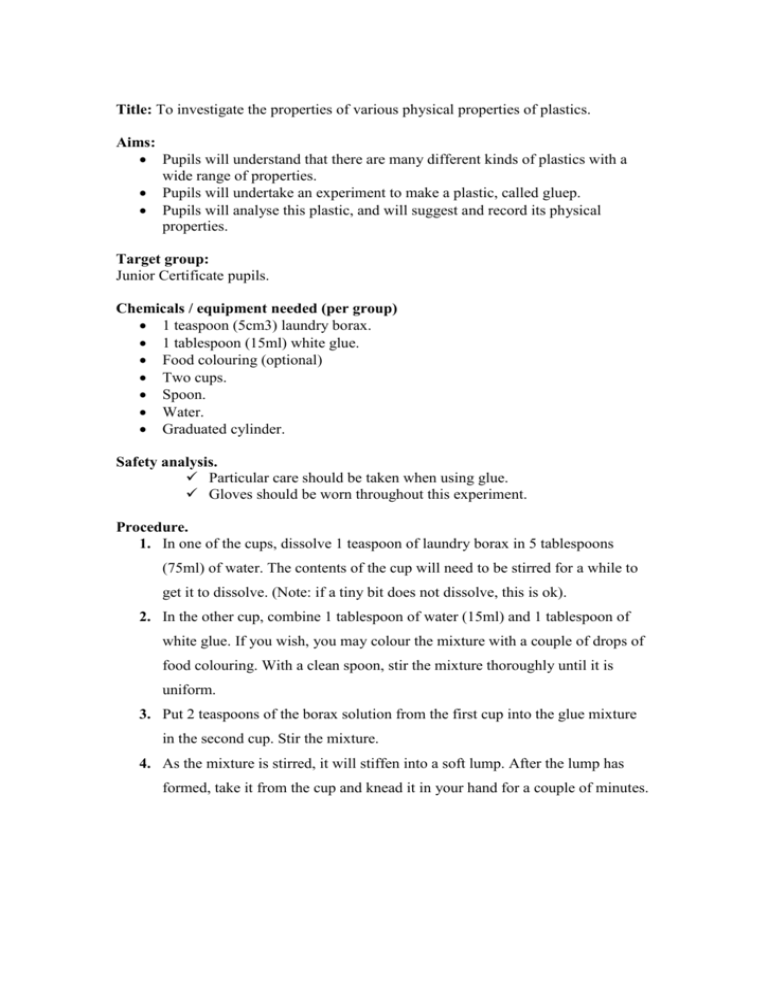
Title: To investigate the properties of various physical properties of plastics. Aims: Pupils will understand that there are many different kinds of plastics with a wide range of properties. Pupils will undertake an experiment to make a plastic, called gluep. Pupils will analyse this plastic, and will suggest and record its physical properties. Target group: Junior Certificate pupils. Chemicals / equipment needed (per group) 1 teaspoon (5cm3) laundry borax. 1 tablespoon (15ml) white glue. Food colouring (optional) Two cups. Spoon. Water. Graduated cylinder. Safety analysis. Particular care should be taken when using glue. Gloves should be worn throughout this experiment. Procedure. 1. In one of the cups, dissolve 1 teaspoon of laundry borax in 5 tablespoons (75ml) of water. The contents of the cup will need to be stirred for a while to get it to dissolve. (Note: if a tiny bit does not dissolve, this is ok). 2. In the other cup, combine 1 tablespoon of water (15ml) and 1 tablespoon of white glue. If you wish, you may colour the mixture with a couple of drops of food colouring. With a clean spoon, stir the mixture thoroughly until it is uniform. 3. Put 2 teaspoons of the borax solution from the first cup into the glue mixture in the second cup. Stir the mixture. 4. As the mixture is stirred, it will stiffen into a soft lump. After the lump has formed, take it from the cup and knead it in your hand for a couple of minutes. Set up diagram: 1 teaspoon of laundry borax + 75ml of water 2 teaspoons 1 tablespoon of water + 1 tablespoon of white glue + food colouring Sample results/ observations: Examine the gluep: 1. Roll the gluep into a ball and then let it rest. Does the ball maintain its shape? No, the ball falls out of shape and goes flat. 2. Drop a gluep ball onto a tabletop. What does the ball do? The ball deflates into a flat shape. 3. Flatten the gluep into a thin strip. Hold the strip by one end. What happens to the strip? The gluep stretches but does not break. 4. Roll the gluep into a cylinder and pull the ends slowly. What happens to the cylinder? The gluep stretches but does not break. 5. Roll the gluep into a cylinder and pull the ends quickly. What happens to the cylinder? The gluep does break when pulled quickly. Conclusions: Plastics are man made- made materials, made mostly from crude oil. Plastics have many uses and properties. It was observed from this experiment that they can be moulded into many different shapes and sizes, they do not tend to be very heavy, and they can be dyed and items of many different colours can then be made from them. Possible questions to ask: - Before the experiment 2. What is plastic? 3. Where do you think it comes from? 4. List some examples of plastics that we use everyday. 5. What types of properties do you think plastics may have? 6. Lets compare these properties with the properties of metals. 7. Conduct a discussion / debate on why pupils think people have to pay for plastic bags nowadays? Do you think this will make a difference to our pollution levels? After the experiment 1. What was the point of the experiment? 2. Can you explain how the experiment was undertaken? 3. From the results, do the physical properties correspond to the list we have already made? Which properties? 4. Can you explain in your own words, why plastics are said to have structures like a chain? These questions include both lower and higher order thinking questions for the pupils. Links to the Irish curriculum. The topic of ‘plastics’ is discussed under section 2c: atomic structure, reactions, and compounds, on the Irish Junior Certificate syllabus. The aims on the syllabus for the plastics include: OC58: Identify everyday applications of plastics, and understand that crude oil products are the raw material for their production. OC59: Relate the properties of plastics to their use. OC60: Describe and discuss the impact of non- biodegradable plastics on the environment. The Junior Cert syllabus does not give an in depth analysis on the topic plastics, and there is no experiment suggested. This experiment ‘to make gluep plastic’ would be a very efficient learning aid for pupils when doing this topic. It would provide active learning, make the topic more appealing/ interesting; and it would greatly improve the ability for pupils to recall the list of properties of plastics. This experiment can be incorporated into the Junior Cert syllabus; is time efficient, simple, and worthwhile. References: Childs, Peter.E. (1990), ‘CEPUP in the schools’, Chemistry in action!, issue no. 32 autumn; 27 An Roinn Oideachas agus Eolaiochta, ‘Junior Certificate Science Syllabus’; 22-23 Dorgan,H., Kennedy,D., Walsh,P. (2003), ‘Junior certificate Science, A voyage of discovery’ ;314-315 ‘Gluep – solid or liquid?’ available: http://scifun.chem.wisc.edu/HOMEEXPTS/gluep.htm, [12/03/2008]

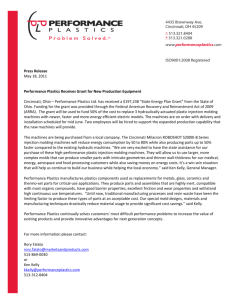


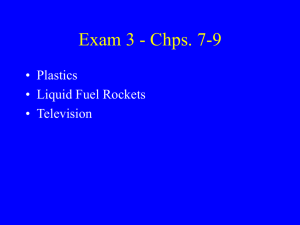


![afl_mat[1]](http://s2.studylib.net/store/data/005387843_1-8371eaaba182de7da429cb4369cd28fc-300x300.png)

